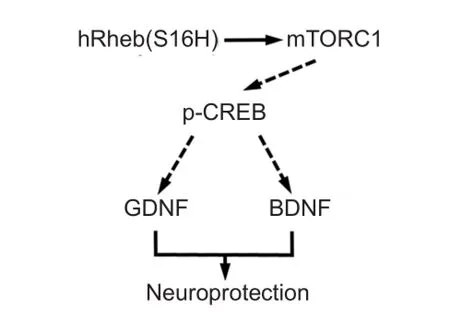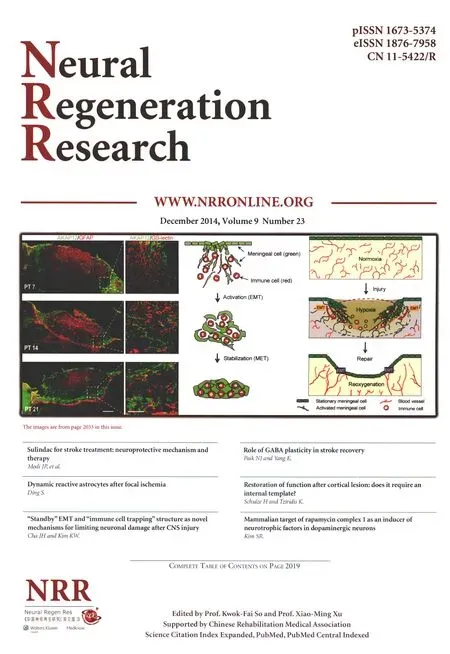Mammalian target of rapamycin complex 1 as an inducer of neurotrophic factors in dopaminergic neurons
Mammalian target of rapamycin complex 1 as an inducer of neurotrophic factors in dopaminergic neurons
The defining neuropathological feature of Parkinson’s disease (PD) is the loss of nigrostriatal dopaminergic (DA) projections. This results in a biochemical reduction of striatal dopamine levels and movement disorders, such as a tremor at rest, rigidity of the limbs, bradykinesia, and postural instability (Kim et al., 2011; Kim et al., 2012; Burke and O’Malley, 2013; Leem et al., 2014; Nam et al., 2014). Because the etiology of PD is not fully understood, it cannot guide the development of knowledge-based targeted therapeutics. However, one treatment area that has gained signi fi cant momentum is the use of various growth factors, such as glial cell line-derived neurotrophic factor (GDNF) and brain-derived neurotrophic factor (BDNF), which are indispensable for the survival of DA neurons (Leem et al., 2014; Nam et al., 2014). GDNF and BDNF are important trophic factors involved in the survival of neurons (Nam et al., 2014). Treatment with GDNF and BDNF is consistently neuroprotective in many animal models of PD. Conversely, conditional ablation of GDNF in adult mice results in a delayed and progressive loss of DA neurons, and infusion of an antisense oligonucleotide speci fi c to BDNF results in anatomical, neurochemical, and behavioral de fi cits associated with PD (Nam et al., 2014). However, there is a critical problem in the use of these factors as a treatment for PD: they do not cross the blood-brain barrier, which is the membrane protecting the brain from exogenous pathogen/toxic agents through the structural and functional complex. Moreover, clinical trials using intracerebroventricular injection and intraputaminal infusion of GDNF failed to be effective in patients with PD, probably because of limited penetration and distribution to target brain areas (Peterson and Nutt, 2008; Nam et al., 2014). Thus, the utilization of GDNF and BDNF in clinical pharmacology and other therapeutics for PD will be dependent upon sustained delivery of the appropriate amount of these factors to target areas in a safe and ef fi cacious manner without producing adverse effects (Jung and Kim, 2014).
Mammalian target of rapamycin (mTOR) kinase exists in two complexes, mTOR complex 1 (mTORC1) and mTORC2, which play central roles in the integration of cell growth in response to environmental conditions, including growth factors, amino acids, energy substrates, and oxygen (Kim et al., 2012). mTORC2 activates Akt by Ser473 phosphorylation, whereas mTORC1 is an important mediator of many effects of Akt on cell growth that are induced by growth factors (Kim et al., 2012). The activation of mTORC1 can phosphorylate and activate ribosomal S6 kinases (S6K1 and S6K2) and inhibits the translational regulator, 4E-BP1. This results in phosphorylation of its downstream effectors that increase mRNA translation involved in cell growth and survival (Han and Sahin, 2011; Kim et al., 2012; Nam et al., 2014).
The cellular effects of GDNF and BDNF are mainly initiated by their binding to speci fi c receptors, such as GDNF family receptor alpha-1 and tropomyosin receptor kinase B, respectively. Treatment with GDNF and BDNF activates the Akt/mTOR signaling pathway in neurons (Nam et al., 2014). Activation of the Akt/mTOR signaling pathway enhances the activity of intracellular cell survival pathways under a variety of conditions, such as the trophic factor withdrawal, ischemic shock, and oxidative stress (Leem et al., 2014; Nam et al., 2014). Moreover, consistent with the decreased levels of GDNF and BDNF in PD brains, decreased levels of Akt phosphorylation, which results in a loss of mTORC1 activation, is observed in the substantia nigra of patients with PD. This is also seen in the 1-methyl-4-phenylpyridinium (MPP+) model of PD, which mimics the phenotype of patients with PD (Selvaraj et al., 2012; Nam et al., 2014). These results indicate that the support of neurotrophic factors and the activation of the mTORC1 signaling pathway are necessary for the survival of DA neurons and functional maintenance of the DA system in the adult brain (Jung and Kim, 2014; Leem et al., 2014; Nam et al., 2014). Therefore, replacement strategies supporting activation of mTORC1, instead of GDNF and BDNF, can be useful to treat neurodegenerative diseases, such as PD.
We have previously reported that the activation of mTORC1 by adeno-associated virus 1 (AAV1) transduction with a gene encoding the constitutively active form of human ras homolog enriched in brain (hRheb) with a mutation of serine to histidine at position 16 [hRheb(S16H)] could induce trophic effects. This resulted in the protection and restoration of DA neurons in the 6-hydroxydopamine (6-OHDA)-treated model of PD (Kim et al., 2011, 2012). However, it was largely unknown whether the activation of mTORC1 could reproduce neurotrophic factors through intracellular signaling pathways in adult neurons of the brain. Recently, we have found that hRheb(S16H) expression by a viral vector could robustly induce GDNF and BDNF in adult DA neurons in vivo, which was signi fi cantly attenuated by treatment with rapamycin, a speci fi c mTORC1 inhibitor (Nam et al., 2014). In addition to the induction of neurotrophic factors, our results using neutralizing antibodies against GDNF and BDNF have shown that Rheb(S16H)-induced trophic factors contribute to the protection of nigrostriatal DA projections via a synergetic mechanism in the MPP+-treated rat model of PD (Nam et al., 2014). These results suggest that a specific gene delivery to DA neurons in the substantia nigra, which can enhance the activation of mTORC1, results in the sustained production of diverse neurotrophic factors that are involved in the maintenance and protection of the nigrostriatal DA system in the adult brain.

Figure 1 Schematic representation of Rheb(S16H)/mTORC1 signaling pathways.
Similar to application of neurotrophic factors, brain surgery is necessary to apply the viral vectors to patients with PD. Although gene therapy using viral vectors to treat patients with PD is still ongoing, the issues of brain surgery suggest that other alternatives, such as natural compounds showing neurotrophic effects through internal medication, can be bene fi cial to prevent the degeneration of nigrostriatal DA projections in the adult brain (Jung et al., 2014). A recent important report has shown that naringin protects nigrostriatal dopaminergic projections in a neurotoxin model of PD (Leem et al., 2014). Naringin is a major flavanone glycoside in grapefruits and citrus fruits. It has been considered a protective agent against neurodegenerative diseases because it can induce anti-oxidant and neuroprotective effects via the induction of neurotrophic factors, such as BDNF and vascular endothelial growth factor, and activate anti-apoptotic pathways (Jung and Kim, 2014; Jung et al., 2014). However, it was unknown whether naringin has neuroprotective effects against the degeneration of nigrostriatal DA projections in the adult brain. Recently, we have demonstrated that naringin protects nigrostriatal DA projections in rat brains (Leem et al., 2014). Our results have shown that intraperitoneal injections of naringin signi fi cantly increase the level of GDNF and activate mTORC1 in nigral DA neurons. In addition, naringin-induced GDNF increase contributes to the neuroprotection of nigrostriatal DA projections in a neurotoxin model of PD (Leem et al., 2014). There is a lack of evidence of the neuroprotective roles of naringin in clinical trials and the mechanisms of naringin-mediated effects in DA neurons are still not fully understood; however, these results suggest that speci fi c fl avonoids, such as naringin, may be bene fi cial natural products that offer promise for the prevention of neurodegeneration.
In conclusion, hRheb(S16H) has robust trophic and protective effects on nigrostriatal DA projections in the adult brain. The sustained production of GDNF and BDNF via an mTORC1-dependent pathway contributes to neuroprotection in animal models of PD (Nam et al., 2014). Similar to these effects, naringin can induce the production of GDNF in adult DA neurons, highlighting it as a therapeutic agent against neurodegeneration through mTORC1 activation (Leem et al., 2014). Although more research is necessary to support these results and to optimize treatment methods, our observations suggest that activation of mTORC1 by speci fi c gene delivery or treatment with speci fi c compounds can induce the production of neurotrophic factors, such as GDNF and BDNF, in DA neurons (Figure 1). This may be a useful strategy to protect and maintain the nigrostriatal DA system in the adult brain.
Sang Ryong Kim
School of Life Sciences, BK21 plus KNU Creative BioResearch Group, Institute of Life Science & Biotechnology, Kyungpook National University, Daegu 702-701, Korea; Brain Science and Engineering Institute, Kyungpook National University, Daegu 700-842, Korea
Burke RE, O’Malley K (2013) Axon degeneration in Parkinson’s disease. Exp Neurol 246:72-83.
Han JM, Sahin M (2011) TSC1/TSC2 signaling in the CNS. FEBS Lett 585:973-980.
Jung UJ, Kim SR (2014) Effects of naringin, a flavanone glycoside in grapefruits and citrus fruits, on the nigrostriatal dopaminergic projection in the adult brain. Neural Regen Res 9:1514-1517.
Jung UJ, Leem E, Kim SR (2014) Naringin: a protector of the nigrostriatal dopaminergic projection. Exp Neurobiol 23:124-129.
Kim SR, Chen X, Oo TF, Kareva T, Yarygina O, Wang C, During M, Kholodilov N, Burke RE (2011) Dopaminergic pathway reconstruction by Akt/Rheb-induced axon regeneration. Ann Neurol 70:110-120.
Kim SR, Kareva T, Yarygina O, Kholodilov N, Burke RE (2012) AAV transduction of dopamine neurons with constitutively active Rheb protects from neurodegeneration and mediates axon regrowth. Mol Ther 20:275-286.
Leem E, Nam JH, Jeon MT, Shin WH, Won SY, Park SJ, Choi MS, Jin BK, Jung UJ, Kim SR (2014) Naringin protects the nigrostriatal dopaminergic projection through induction of GDNF in a neurotoxin model of Parkinson’s disease. J Nutr Biochem 25: 801-806.
Nam JH, Leem E, Joen MT, Jeong KH, Park JW, Jung UJ, Kholodilov N, Burke RE, Jin BK, Kim SR (2014) Induction of GDNF and BDNF by hRheb(S16H) transduction of SNpc neurons: Neuroprotective mechanisms of hRheb(S16H) in a model of Parkinson’s disease. Mol Neurobiol DOI: 10.1007/s12035-014-8729-2.
Peterson AL, Nutt JG (2008) Treatment of Parkinson’s disease with trophic factors. Neurotherapeutics 5:270-280.
Selvaraj S, Sun Y, Watt JA, Wang S, Lei S, Birnbaumer L, Singh BB (2012) Neurotoxin-induced ER stress in mouse dopaminergic neurons involves downregulation of TRPC1 and inhibition of AKT/mTOR signaling. J Clin Invest 122:1354-1367.
Sang Ryong Kim, Ph.D.
Email: srk75@knu.ac.kr.
10.4103/1673-5374.147923 http://www.nrronline.org/
Accepted: 2014-11-25
Kim SR. Mammalian target of rapamycin complex 1 as an inducer of neurotrophic factors in dopaminergic neurons. Neural Regen Res. 2014;9(23):2036-2037.
- 中国神经再生研究(英文版)的其它文章
- Sulindac for stroke treatment: neuroprotective mechanism and therapy
- Angioplasty and stenting for severe vertebral artery ori fi ce stenosis: effects on cerebellar function remodeling veri fi ed by blood oxygen level-dependent functional magnetic resonance imaging
- Lesion localization of global aphasia without hemiparesis by overlapping of the brain magnetic resonance images
- A novel functional electrical stimulation-control system for restoring motor function of post-stroke hemiplegic patients
- Neurotrophins and their receptors in satellite glial cells following nerve injury
- Dynamic reactive astrocytes after focal ischemia

